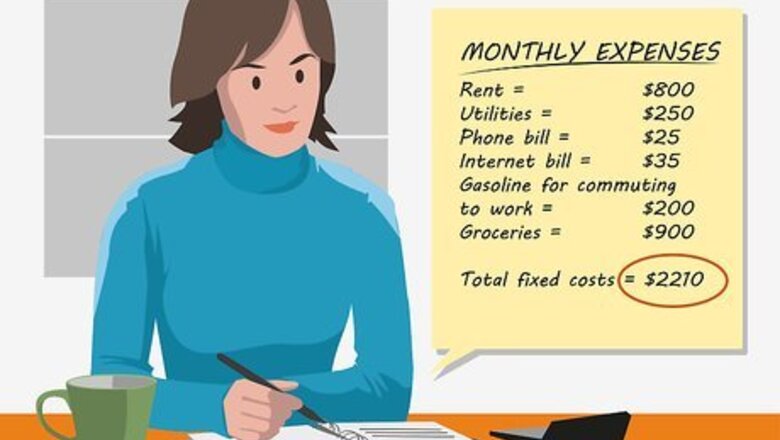
views
Calculating Total Cost for a Personal Budget
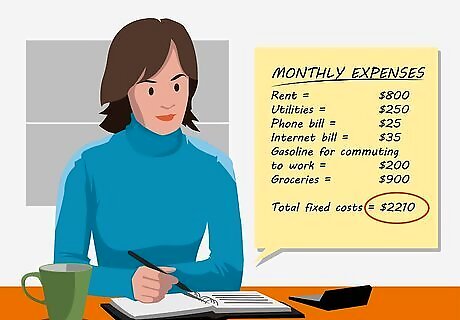
Calculate your fixed costs. Start finding your total cost of living by tallying up all of your fixed costs for the time period you're looking at. Note that most (but not all) personal budgets are calculated monthly. In this case, fixed costs are expenses that must be paid every month. These include rent, utilities, phone bills, gasoline for the car, groceries, and so on. Fixed costs do not change very much (if at all) from month to month.These are costs that don't increase or decrease depending on how much personal spending you do in a month — for instance, if you go on a shopping spree at your favorite clothing store, your rent won't go up. As an example, let's say that we need to put together a personal budget to save money. In our case, our fixed costs are: rent = $800, utilities = $250, phone bill = $25, internet bill = $35, gasoline for commuting to work = $200, and groceries = $900. Adding these up, we find that our total fixed costs are $2210.
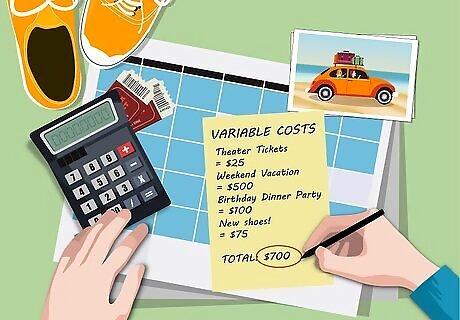
Add up your variable costs for one month. In contrast to fixed costs, variable costs depend on your lifestyle and include all expenses that are not strictly necessary, but that improve your quality of life. Variable costs include expenses like shopping trips, nights out, clothing (beyond what you need), vacations, parties, gourmet food, etc. Note that, even though expenses like utility bills can vary slightly from month to month, they aren't variable costs because they're not optional. In our example situation, let's say that our variable costs include: money for theater tickets = $25, weekend vacation = $500, dinner party for a friend's birthday = $100, and a new pair of shoes = $75. This would bring our total variable costs to $700.
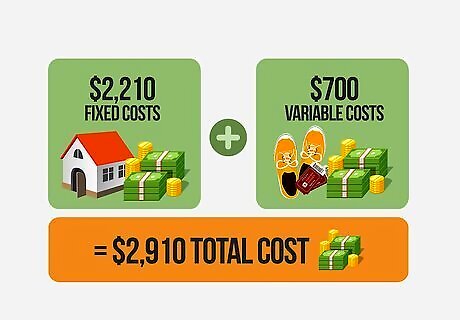
Add your fixed costs to your variable costs to get your total cost. Your total cost of living on your budget is the total amount of money you spent over a one month period. The formula for finding this is simply fixed costs + variable costs = total cost. Using the examples of fixed costs and variable costs given above, we would calculate our total cost as follows: $2210 (fixed costs) + $700 (variable costs) = $2910 (total cost).
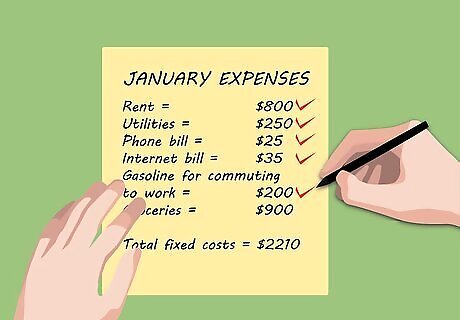
Track your spending to determine your monthly expenses. Unless you're already practicing very good financial habits, you may not keep track of every single expense in a given month. This means that you can run into problems when you have to total up all of your expenses at the end of the month. To remove guesswork from the equation, try actively tracking your expenses for one full month. After this, you'll have a good idea of your fixed costs, so you'll only need to track your variable costs in the future. Tracking fixed costs is easy — simply keep track of your housing expenses (rent, etc.) and save every major monthly bill you receive for that month and you'll have a good deal of the work done. Groceries can be a little messier to keep track of, but if you keep your receipts or monitor your checking account transactions online, it shouldn't be hard to get an accurate total. Tracking variable costs can be a little more difficult. If you use credit or debit cards to make all of your purchases, you can simply add your expenses at the end of the month by using your online banking profile (nearly all checking accounts and credit card accounts now give you this option for free.) On the other hand, if you make lots of cash or check purchases, you'll want to save your receipts or write down the amount of money you spend with each purchase.
Calculating the Total Cost for a Business
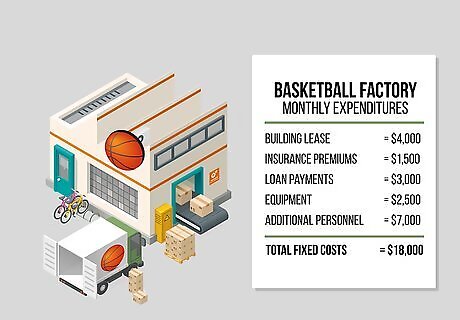
Add up your business's fixed costs. In the world of business, fixed costs are often referred to as overhead costs. This is the money the business needs to spend simply to keep operating. More accurately, we can say that fixed costs are the costs that do not increase or decrease as the business produces more or fewer goods and services. Fixed costs for a business are similar to (but not exactly the same as) those for a personal budget. A business's fixed costs include rent, utilities, building leases, equipment, machinery, insurance premiums, and labor not involved in the production of the goods and services. Fixed costs are the costs that repeat every month. For example, let's say that we own a basketball factory. Our monthly fixed costs include: building lease = $4,000, insurance premiums = $1,500, loan payments = $3,000, and equipment = $2,500. In addition, we pay $7,000 per month for workers that don't directly affect the production of our basketballs — janitors, security guards and so on. Adding these up, we get a value for our fixed costs of $18,000.
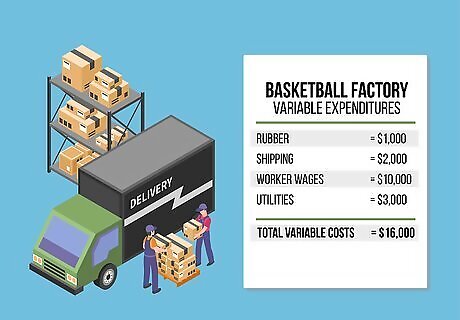
Figure out your variable costs. In business, variable costs are a little different than they are for personal budgets. A business's variable costs are the expenses that are directly affected by the amount of goods or services produced. In other words, the more a business creates (in terms of products produced, services rendered, and so on), the greater its variable costs will be. Variable costs for a business include things like raw materials, shipping expenses, labor that is involved in the production process, and so on. In addition, utilities can be a variable expense if they fluctuate with the output of your business. For example, since a robotic car factory uses a large amount of electricity and since the amount of electricity needed will increase as more cars are produced, utilities can be classified as a variable cost. In our basketball factory example, let's say that our variable costs include: rubber = $1,000, shipping = $2,000, factory worker wages = $10,000. In addition, our factory uses a large amount of natural gas for the rubber vulcanization process and this cost increases as production ramps up — this month's utilities bill was $3,000. Adding up our expenses, we get total variable costs of $16,000.
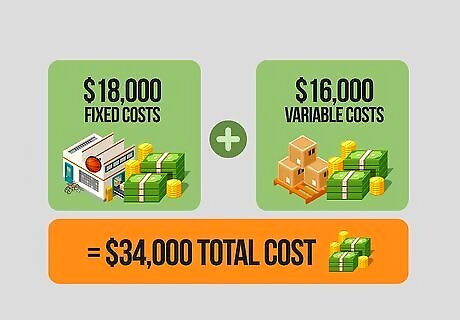
Add your fixed and variable costs to determine your total cost. As with personal budgets, the formula for calculating a business's total costs is quite simple: Fixed Costs + Variable Costs = Total Cost. In our example, since our fixed costs are $18,000 and our variable costs are $16,000, our total monthly cost for the factory is $34,000.
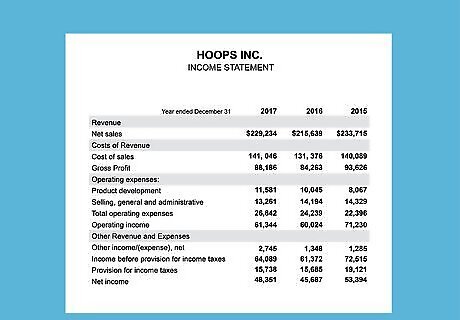
Find your business's costs on its income statement. Most businesses' fixed and variable costs can be found on their financial documents. Specifically, the income statement should contain all of the variable costs tied to the production of the business's goods and services in addition to crucial fixed costs like rent, utilities, and so on. The income statement is a standard financial document — nearly all businesses with some sort of accounting operation should have one. In addition, you may want to consult another document called a balance sheet to determine how much money the business needs to pay back in the future. The balance sheet contains (in addition to other important figures) a business's liabilities — the money it owes to others. This can help you determine your business's financial health: if you're just barely making enough money to meet your total cost and you have major liabilities, your business may be in an unfavorable position.
Calculating the Total Cost of an Investment
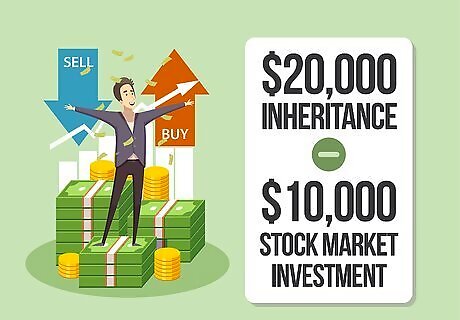
Find the initial price of the investment. When it comes to determining the cost of an investment, your expenses usually don't begin and end with the money you put into the stock, mutual fund, etc. For people without direct access to the stock market (i.e., most ordinary people), it's necessary to use an investment adviser or broker to help build a portfolio and, because these experts don't work for free, the cost will be a little higher than the money set aside for the investment. Start determining the cost of your investment by identifying the amount of money you plan to use purely for the investment. As an example, let's say that we've recently inherited $20,000 from an obscure relative and that, rather than squandering it all on a luxurious vacation, we want to invest half of it in the stock market to get some long-term potential out of it. In this case, we'll say that we are investing $10,000.
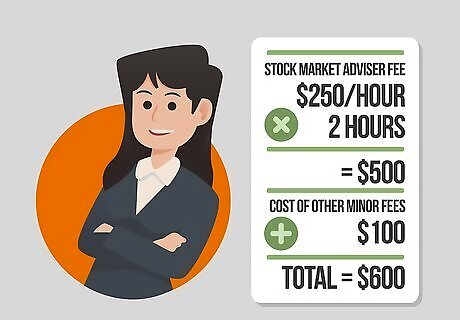
Account for any fees. As noted above, investment advisers don't usually work pro bono. Generally, an adviser will need to be paid in one of two ways: via a flat fee (usually hourly) or via a commission (usually a percentage of the investment). In both cases, determining the impact on the total cost is simple. For fee-based investment services, multiply the adviser's hourly rate by the amount of time spent on your portfolio and include any minor associated fees. For the purposes of our example, let's say that our chosen adviser charges $250/hour (not bad — prices can easily range to $500/hour). If she agrees that it will take two hours of work to put together our portfolio, her fee will be $500. Let's say we need to add $100 to this in the form of various minor fees and we get a total of $600.
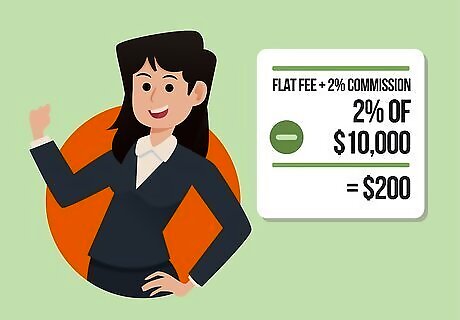
If necessary, add the commission. Another way to pay your adviser for handling your investments is in the form of a commission. This is generally a small percentage of whatever you buy through the adviser. The more money you invest, the smaller the percentage usually is. In our example, let's say that, on top of her flat fee, our adviser also charges a 1% commission. This is only for example purposes — in the real world, it's usually either one form of payment or the other, not both. In this case, since 2% of the $10,000 we want to invest is $200, we'll add this to our total cost. A word of caution: because their pay is determined by how much you buy and sell, some commissioned investment advisers have been known to act unethically, convincing clients to ditch old stocks and buy new ones frequently in an effort to line their own pockets. Only use the services of advisers that you know and trust. If all else fails, flat fee-paid advisers tend to have less of an incentive for conflicts of interest.
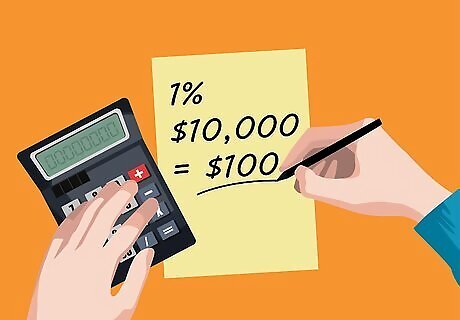
Account for taxes. Finally, add the cost of any government taxes incurred as part of the investment process. In the U.S., taxes can be (and are) levied on investment income after you've already invested your money, but, when determining the total cost of an investment, you're generally more worried about taxes that are levied up-front. These can vary from locality to locality, so talk to a trusted investment adviser about your tax burden before you agree to invest. In our example, let's say that there is a 1% tax on all major investments (in the real world, again, this may or may not be the case where you live.) In this case, since 1% of $10,000 is $100, we'll add this to our total cost.
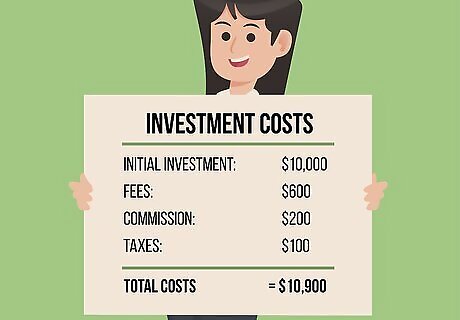
Add it all up. Once you know your initial investment, any associated fees and commissions, and any expected taxes, you're ready to find its total cost — simply add each individual cost together. Let's solve our example problem: Initial investment: $10,000 Fees: $600 Commission: $200 Taxes: $100 Total: $10,900












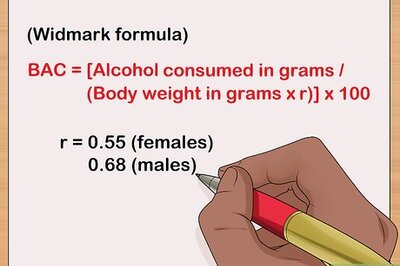




Comments
0 comment